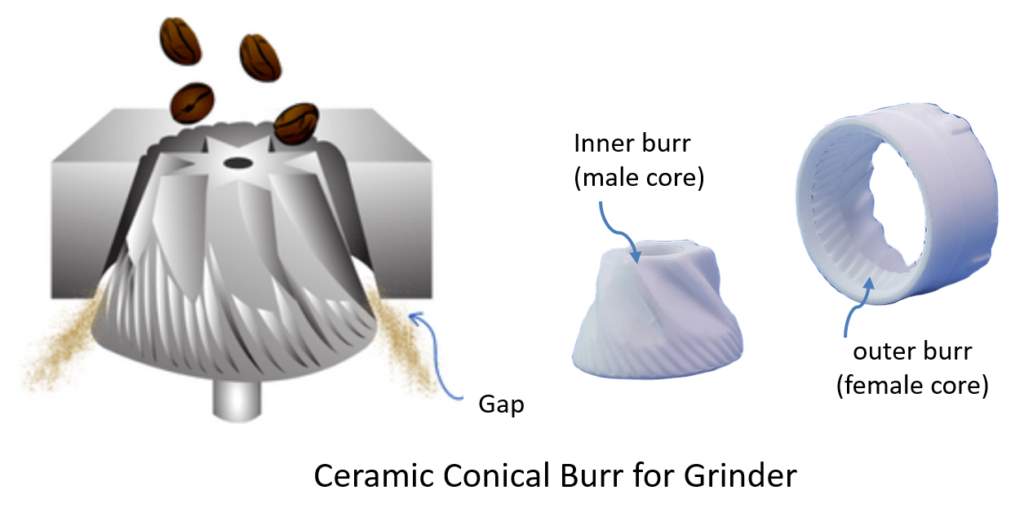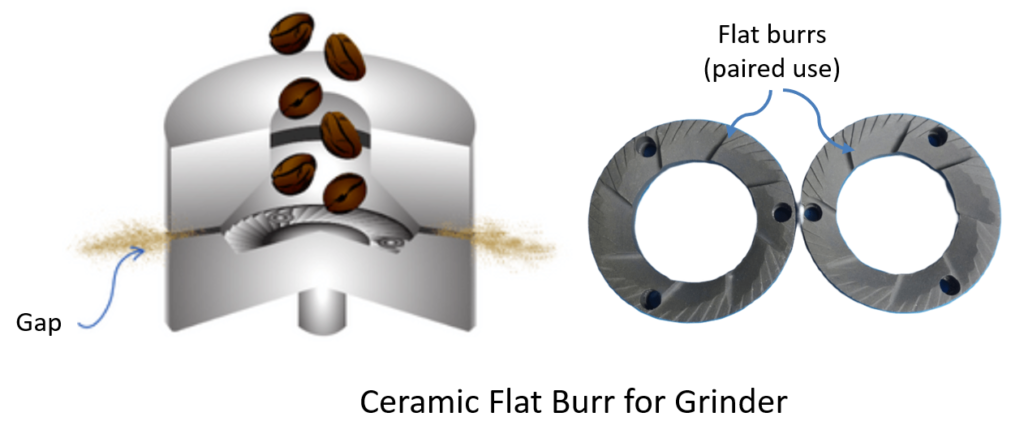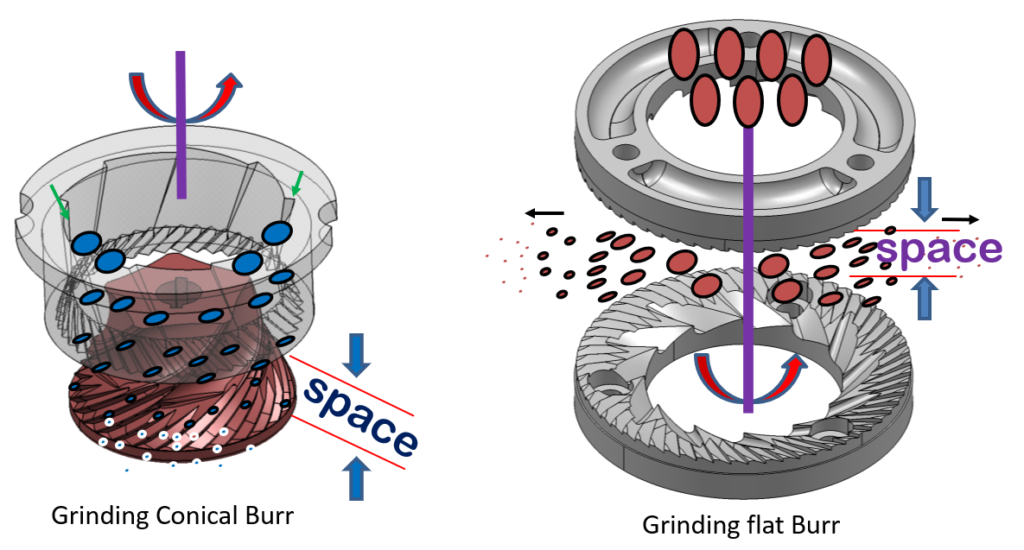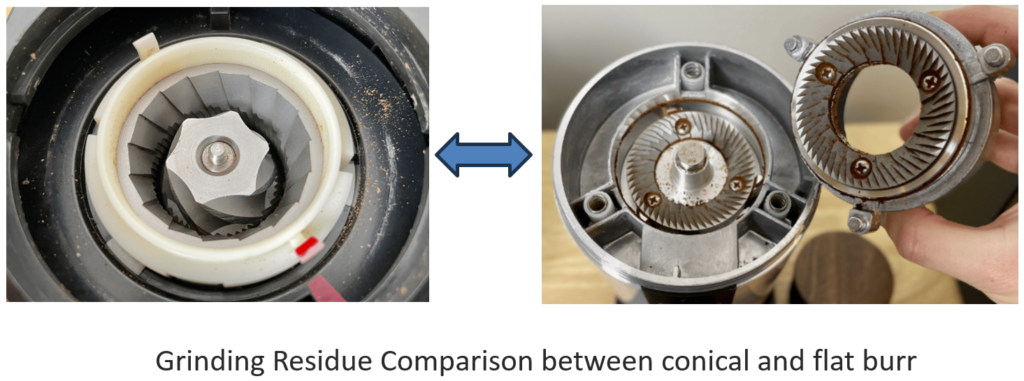In daily life coffee beans, pepper grains, coarse salt, spices and other initial large particles need to be crushed and refined, we basically use the grinder to do it more efficiently, the grinder has a distinction between home and business, as well as electric and manual. The most central component on a grinder is the grinding core, which is the key functional component. As the raw particles pass through the gaps between the matching grinding cores, they are transferred between the cores by external pressure, which crushes and refines the particles. Currently, the grinding cores in grinders are divided into flat and conical burrs with shapes, ceramic and metal burrs with materials, and abrasive burr and blade according to their particle refinement methods. In this section we focus on two different shapes of ceramic cores, conical and flat.
What are Grinder Ceramic Conical and Flat Burr?
1.Conical Burr
 Conical grinding core consists of outer burr (female core) and inner burr (male core), outer burr is a cylindrical cavity, the inner wall is vertically arranged with two kinds of teeth, the upper teeth sparse and large, the lower row of teeth dense and fine. Inner burr is a conical solid body, the bottom is larger, the outer wall is also vertically arranged with two kinds of teeth, similar to the outer burr, the upper side of the teeth sparse and large, the lower row of teeth dense and fine. The female core and male core are vertically fitted to each other, and the male core is placed in the female core to form a vertically inclined gap, and the female core is equivalent to the base, which is generally immobile, and the male core is rotating (some grinders can also be designed to make the male core immobile, and the female core rotating). Original particles from the top gap into the particles are first pulled into the gap by the coarse teeth, through the extrusion friction, preliminary tearing split, relying on their own gravity, and then sink to the bottom of the gap, because the gap is getting smaller and smaller, and more and more dense teeth, the particles are grinding more and more small, and finally to reach the demand for the fineness, and then come out of the bottom of the gap. From the process can be seen, adjusting the size of the gap between the outer burr and inner burr, also determines the degree of coarse and fine particle grinding.
Conical grinding core consists of outer burr (female core) and inner burr (male core), outer burr is a cylindrical cavity, the inner wall is vertically arranged with two kinds of teeth, the upper teeth sparse and large, the lower row of teeth dense and fine. Inner burr is a conical solid body, the bottom is larger, the outer wall is also vertically arranged with two kinds of teeth, similar to the outer burr, the upper side of the teeth sparse and large, the lower row of teeth dense and fine. The female core and male core are vertically fitted to each other, and the male core is placed in the female core to form a vertically inclined gap, and the female core is equivalent to the base, which is generally immobile, and the male core is rotating (some grinders can also be designed to make the male core immobile, and the female core rotating). Original particles from the top gap into the particles are first pulled into the gap by the coarse teeth, through the extrusion friction, preliminary tearing split, relying on their own gravity, and then sink to the bottom of the gap, because the gap is getting smaller and smaller, and more and more dense teeth, the particles are grinding more and more small, and finally to reach the demand for the fineness, and then come out of the bottom of the gap. From the process can be seen, adjusting the size of the gap between the outer burr and inner burr, also determines the degree of coarse and fine particle grinding.
2.Flat Burr
 The shape of the flat burr is circular, with neatly arranged teeth on the working surface, similar to a donut. The teeth of the core gradually become denser from the inside to the outside, two pairs of flat burrs are arranged face-to-face parallel to each other and leave a certain gap. When working through the external force, the two grinding burrs rotate relatively, the original particles from the middle of the circular cavity space into the coarse teeth pulled into the gap between the two grinding burrs, began to be decomposed. With the thrust generated during the rotation, the particles move deeper into the gap, the gap becomes smaller, and the biting teeth become finer, thus the particles are also ground finer, to the outer circular edge of the gap, basically reaching the required particle size.
The shape of the flat burr is circular, with neatly arranged teeth on the working surface, similar to a donut. The teeth of the core gradually become denser from the inside to the outside, two pairs of flat burrs are arranged face-to-face parallel to each other and leave a certain gap. When working through the external force, the two grinding burrs rotate relatively, the original particles from the middle of the circular cavity space into the coarse teeth pulled into the gap between the two grinding burrs, began to be decomposed. With the thrust generated during the rotation, the particles move deeper into the gap, the gap becomes smaller, and the biting teeth become finer, thus the particles are also ground finer, to the outer circular edge of the gap, basically reaching the required particle size.
Comparison of Conical and Flat Burr
1.Grind Consistency
Due to the different structure of conical and flat burrs, there are some differences in the effect of grinding particles.
The final grinding particles of the conical core will have two kinds of results: ultra-small grinding particles and large grinding particles, because the particles are in the vertical gap space to complete the refinement, and mainly rely on their own gravity to enter the extrusion space, because of the rotational speed and the position of the circumference of the formation of the "chance", when it is in the lower part of the small gear gap, stay relatively little time, and some of the particles in the small gear gap, when it leaks out of the small gap, the grinding particles will be larger, and some of the particles in the small gap will be larger. When it leaks out from the small gap, the grinding particles will be larger, and if part of the particles in the gap of the small rodent teeth stay longer, it will naturally grind more fine.
For flat grinding core, because the core is placed parallel to the working space is horizontal, particles in the gap can be fully squeezed in time and space, and rely purely on the power generated by the rotation and tooth shape of the guide, the particles from the center to the outer end of the circumference of the push, so the consistency of the particles is relatively good. Flat grinding core in the grinding due to the friction is sufficient to pay attention to the heat it generates, to consider the timely dissipation of heat or stagnation for a period of time to cool down, the accumulation of heat may be grinded consistency becomes poorer, the heat will also change the related particles such as the flavor of coffee beans.
2.Noise
The noise generated by the two types of grinding cores during operation is also related to its structure and working efficiency, and of course to the materials used in the grinder itself, and the rotational speed at which it works.
 Conical grinding core due to the vertical gap way, the particles do not need to rely on external power, itself can rely on its own gravity to move down, go to push the motor required to rotate the force can be relatively less, the particles themselves in the gap when the extrusion is relatively insufficient, the power of the motor means that the noise is small, so the grinding noise generated by the relatively less.
Conical grinding core due to the vertical gap way, the particles do not need to rely on external power, itself can rely on its own gravity to move down, go to push the motor required to rotate the force can be relatively less, the particles themselves in the gap when the extrusion is relatively insufficient, the power of the motor means that the noise is small, so the grinding noise generated by the relatively less.
As for the flat core, in the gap placed horizontally, the particles are fully ground, the area is large, the resistance of the formation of the force arm is long, the corresponding torque needs to be larger, itself also need to rotate to bring the kinetic energy so that the particles are squeezed into the gap, can be pushed each other to the circumference out of the gap, the rotation speed needs to be higher (about 700 RPM), the need for high power motors. The above factors cause the noise generated by the work of the flat core is relatively large, sometimes flat core grinding at high speeds, will produce ear-splitting whistling (may need to change the material to improve).
3.Grinding Residue
Grinding retention is understood to be the small amount of particles that remain on the grinding surface after the particles have been ground and normally discharged for use. The reason why this residual amount is used as a comparative item is that in each grinding process, if there is always a residual amount of these particles, for particles such as coffee beans, it will lead to the taste of the processed coffee beans, deterioration, affecting the taste and quality.
 For the conical core, due to its vertical cavity and its own gravity push, the normal particles of powder from the bottom of the cavity out, the amount of retention is relatively small, especially to accommodate the particles of the cavity, mostly in the sparse and large between the teeth of the engagement, it is more difficult to adhere to the excess particles, self-cleaning ability to be stronger. Obviously, because of the horizontal arrangement of the cavities of the flat core, it is purely by the rotation of the two flat cores to promote the movement of the particles, there is no gravity to assist the role of the natural particles of fines left in the cavity. Of course, this is only a comparison of the amount of residue in the usual sense, some mills using flat cores, more design a cleaning system or structural design optimization, it is also possible to maintain a smaller amount of residue.
For the conical core, due to its vertical cavity and its own gravity push, the normal particles of powder from the bottom of the cavity out, the amount of retention is relatively small, especially to accommodate the particles of the cavity, mostly in the sparse and large between the teeth of the engagement, it is more difficult to adhere to the excess particles, self-cleaning ability to be stronger. Obviously, because of the horizontal arrangement of the cavities of the flat core, it is purely by the rotation of the two flat cores to promote the movement of the particles, there is no gravity to assist the role of the natural particles of fines left in the cavity. Of course, this is only a comparison of the amount of residue in the usual sense, some mills using flat cores, more design a cleaning system or structural design optimization, it is also possible to maintain a smaller amount of residue.
4.Cost
Cost is a less precise judgment factor, with the material, purity, structure, technical requirements, the use of conditions have a greater relationship. Ceramics with conical core conventional 95% or low alumina ceramics, some customers only need steatite material, used to grind some coarse salt, pepper grains, etc., often supporting in the disposable manual grinder, the core requirements are not very high, so the cost of conical core is relatively low. Ceramic flat core is generally 99% or 95% aluminum oxide, the customer is relatively strict on the size and other requirements, mostly used for grinding coffee machines, and some coffee grinders are more electric, high-end also exquisite and generous, flat core price is correspondingly higher. Overall, the flat core because of the large area, the material used is relatively good, and the related technical requirements are also strict, the overall cost of the flat core is higher than the cost of the conical core.
Final Thoughts
Above, there is a general comparison of the advantages and disadvantages of conical and flat grinding cores, and to help you have a better understanding and comparison, the table below summarizes the information stated above.
| grinder burr type | PROS | CONS |
|---|---|---|
| CONICAL BURR | Low cost; Low heat; Low noise; Easy to clean |
creat bimodal grounds |
| FLAT BURR | Good grind consistency; Suitable for high-end grinders |
Expensive; Noisy; Tend to heat |
Jinghui Industry Ltd. specializes in manufacturing various conical and flat ceramic grinding cores, and related grinding core kits, our products meet the technical requirements of FDA and LFGB, and can be customized according to your requirements. If you have more business to inquire, please do not hesitate to contact us.

